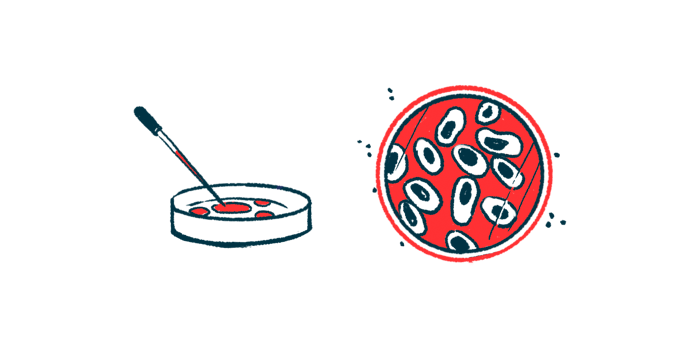Researchers discover cell pathway that prevents TDP-43 aggregation
Treatments sought that join SUMO2, TDP-43 as 'molecular glues'

Researchers have discovered a pathway in cells that prevents the formation of TDP-43 protein clumps, which contribute to nerve cell damage in nearly all people with amyotrophic lateral sclerosis (ALS).
The findings may aid ALS therapies that can activate the pathway and potentially limit TDP-43 clumping and prevent nerve cell death.
“Our cell culture experiments provide a first proof-of-principle: this pathway can help cells to limit disease-promoting TDP-43 aggregates,” Stefan Müller, PhD, professor at Goethe University’s Institute of Biochemistry II and the study’s corresponding author, said in a university news story. “Even if the road to developing a possible drug for treating ALS is still very long, it is definitely worth pursuing this approach further.”
The discovery was detailed in the study, “Induced proximity to PML protects TDP-43 from aggregation via SUMO–ubiquitin networks,” in Nature Chemical Biology.
TDP-43 helps process certain RNA molecules within the cell’s nucleus, where genetic material is stored. In ALS, however, an abnormal form of TDP-43 accumulates in the cytoplasm, the fluid-filled space outside the nucleus. This can interfere with cellular functions and lead to the death of the nerve cells that control voluntary movements, called motor neurons. Abnormal TDP-43 aggregation has also been associated with other neurodegenerative disorders, including Alzheimer’s disease and frontotemporal dementia.
“TDP-43 aggregates are also found in other neurodegenerative diseases, such as frontotemporal dementia (FTD) and in around half of all Alzheimer’s patients,” Müller said.
Studies suggest some TDP-43 is released from the nucleus in response to cellular stress and temporarily accumulates in the cytoplasm as stress granules, dense clusters of proteins and RNA molecules that form temporarily in response to cellular stressors, allowing cells to shut down certain activities.
Normally, when cellular stress is resolved, stress granules disassemble and TDP-43 relocates back to the nucleus. It has been proposed that when the granules persist after stress has resolved, TDP-43 forms solid clumps, like those in ALS.
“The formation of such stress granules is a normal process and serves the cell as a temporary protective space for proteins so that they are immediately available to the cell once the stress has subsided,” said Jan Keiten-Schmitz, PhD, one of the study’s first authors at Goethe. “However, if TDP-43 is mutated, as it is in the cells of many ALS patients, the stress granules persist, increasingly solidify, and ultimately damage the neurons.”
In previous work, the researchers found TDP-43 is modified by multiple copies of another protein called SUMO2 in response to stress.
Limiting TDP-43 clumping in ALS
Here, they created a single protein in which TDP-43 was directly fused to one copy of SUMO2 (SUMO2-TDP-43) or to four copies of SUMO2 (tetra-SUMO2-TDP-43). Then they expressed these fusion proteins in cells with or without stress, either using heat or sodium arsenite, a stress-inducing agent.
In control cells without stress, TDP-43 alone, along with the SUMO2 fusion proteins, didn’t clump.
However, 80% of TDP-43 formed clumps when cells were exposed to heat, while SUMO2-TDP-43 remained partly soluble, and tetra-SUMO2-TDP-43 was predominantly soluble. Similarly, when cells were exposed to sodium arsenite, 40% of TDP-43 formed clumps, while less than 10% of SUMO2-TDP-43 formed clumps. Clumping was almost completely prevented with tetra-SUMO2-TDP-43 in these conditions.
“This data indicate that the attachment of SUMO2 … to TDP-43 limits its aggregation propensity under stress,” wrote the researchers, who then asked if the attachment of SUMO2 alters the interactions between TDP-43 and other proteins in cells. Their experiments revealed that tetra-SUMO2-TDP-43 interacted with proteins that were physically and functionally linked to promyelocytic leukemia protein (PML) nuclear bodies, also known as PML-NBs. These bodies are structures within the nucleus that capture and degrade certain proteins as part of nuclear protein quality control.
Researchers showed that recruitment to PML-NBs enhanced TDP-43 ubiquitylation, the process wherein proteins are marked for degradation. Moreover, interacting with PML limited TDP-43 clumping.
With SUMO2, “TDP-43 remains soluble, and the nuclear bodies — like a mechanic — ensure that harmful forms of TDP-43 are restored or broken down by the cellular recycling system,” Wagner said.
“We propose a model where PML NBs orchestrate [ubiquitin] signaling to protect cells from TDP-43 aggregates and accumulation in cytosolic [stree granules],” the researchers wrote.
The team is looking for treatment candidates that bring SUMO2 and TDP-43 together and act as “molecular glues” to limit the aggregation of TDP-43.




